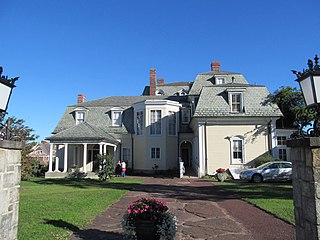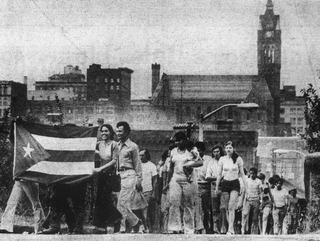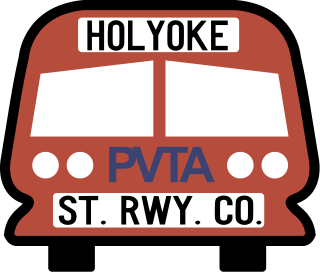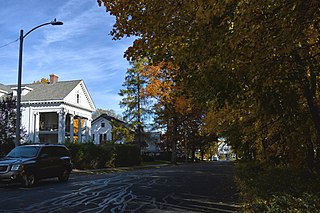
Holyoke is a city in Hampden County, Massachusetts, United States, that lies between the western bank of the Connecticut River and the Mount Tom Range. As of the 2010 census, the city had a population of 39,880. As of 2019, the estimated population was 40,117. Located 8 miles (13 km) north of Springfield, Holyoke is part of the Springfield Metropolitan Area, one of the two distinct metropolitan areas in Massachusetts.

Western Massachusetts is a region in Massachusetts, one of the six U.S. states that make up the New England region of the United States. Western Massachusetts has diverse topography; 22 colleges and universities, with approximately 100,000 students; and such institutions as Tanglewood, the Springfield Armory, and Jacob's Pillow.

Holyoke Community College (HCC) is a public community college in Holyoke, Massachusetts. It offers associate degrees and certificate programs, as well as a transfer program for students to earn credits for transfer to other colleges. It was the first community college established in Massachusetts, as it was founded by the city's school board in 1946, while others were subsequently chartered under state jurisdiction after 1960. HCC currently offers more than 100 associate degree and certificate options, as well as adult basic education/GED programs, education and training for business and industry, and noncredit community education classes. In a 2016 report on community colleges in the United States, the Aspen Institute and Columbia University's Community College Research Center cited HCC as among 2-year community colleges with best practices for student transfers to 4 year institutions such as the University of Massachusetts Amherst. Additionally among the 15 community colleges in Massachusetts, HCC has the highest percentage of student graduates completing associate degrees and certificate programs.

Donald James Ross was a golf course designer. He was born in Dornoch, Scotland, but became a citizen of and spent most of his adult life in the United States. Ross started his career by being an apprentice to Old Tom Morris at St Andrews in Scotland around 1899. With the help of an American agronomy student, fellow Scotsman Robert White from St. Andrews, Ross decided to move to America. Ross invested all his life savings to move to the United States and walked off the boat with only $2. In America, he got his first job at Oakley Country Club in Watertown, Massachusetts. He quickly rose to the position of golf professional at Pinehurst Resort in North Carolina, where he began his course designing career.

Holyoke Heritage State Park is history-oriented state park located in the city of Holyoke, Massachusetts. The park opened in 1986 on the site of the William Skinner Silk Mill which was lost to fire in 1980. The park is managed by the Massachusetts Department of Conservation and Recreation.

Wistariahurst is a historic house museum and the former estate of the Skinner family, located at 238 Cabot Street in Holyoke, Massachusetts. It was built in 1868 for William Skinner, the owner of a successful silk spinning and textile business, and is named for the abundant wisteria vines which cascade across its eastern facade. Originally constructed in Williamsburg in 1868, the mansion designed by Northampton architect William Ferro Pratt was moved to Holyoke in 1874, following the devastating flood which swept away the original Skinner mills. Following the death of Belle Skinner, its music room was operated as a private museum from 1930 to 1959, housing the Belle Skinner Collection of Old Musical Instruments, before their donation by the family to Yale University. Since 1959 it has been operated as the Wistariahurst Museum, and is open to the public. The property was listed on the National Register of Historic Places in 1973.

George Perkins Bissell Alderman, often referred to as George P. B. Alderman was an American architect who was very active in western Massachusetts and Connecticut during the late 19th and early 20th Century.

La Justice was a weekly New England French newspaper published by the LaJustice Publishing Company of Holyoke, Massachusetts from 1904 until 1964, with issues printed biweekly during its final 6 years. Throughout its history the newspaper reported local as well as syndicated international news in French, along with regular columns by its editorship discussing Franco-American identity.

Rock Valley, sometimes referred to as West Holyoke, is a neighborhood in Holyoke, Massachusetts located to the west of the city center, approximately 3 miles (4.8 km) from downtown, bordering Easthampton, Southampton, Westfield, and West Springfield. Rock Valley is historically Holyoke's second oldest village after Elmwood, with its eponymous burial ground dating to around 1777, and families having settled in the area as early as 1745. Predating the construction of the Hadley Falls Dam, it originated as the western section of the 3rd parish of West Springfield. Today the neighborhood contains several historic Federal and Colonial homesteads, in addition to many modern developments adjacent to agricultural and wetland tracts.

As of the 2010 census, Holyoke, Massachusetts had the largest Puerto Rican population, per capita, of any city in the United States outside Puerto Rico proper, with 44.7% or 17,826 residents being of Puerto Rican heritage, comprising 92.4% of all Latinos in the community. From a combination of farming programs instituted by the US Department of Labor after World War II, and the housing and mills that characterized Holyoke prior to deindustrialization, Puerto Ricans began settling in the city in the mid-1950s, with many arriving during the wave of Puerto Rican migration to the Northeastern United States in the 1980s. A combination of white flight as former generations of mill workers left the city, and a sustained influx of migrants in subsequent generations transformed the demographic from a minority of about 13% of the population in 1980, to the largest single demographic by ancestry in a span of three decades.

The Holyoke Street Railway (HSR) was an interurban streetcar and bus system operating in Holyoke, Massachusetts as well as surrounding communities with connections in Amherst, Belchertown, Chicopee, Easthampton, Granby, Northampton, Pelham, South Hadley, Sunderland, Westfield, and West Springfield. Throughout its history the railway system shaped the cultural institutions of Mount Tom, being operator of the mountain's famous summit houses, one of which hosted President McKinley, the Mount Tom Railroad, and the trolley park at the opposite end of this funicular line, Mountain Park.
Springfield Commonwealth Academy is a private middle- and high school in Springfield, Massachusetts.

During the late 19th and early 20th centuries Holyoke saw an influx of Franco-Americans, predominantly French-Canadians, who immigrated to Massachusetts to work in the city's growing textile and paper mills. By 1900, 1 in 3 people in Holyoke were of French-Canadian descent, and a 1913 survey of French Americans in the United States found Holyoke, along with other Massachusetts cities, to have a larger community of French or French-Canadian born residents than those of New Orleans or Chicago at that time. Initially faced with discrimination for the use of their labor by mill owners to undermine unionization, as well as for their creation of separate French institutions as part of the La Survivance movement, this demographic quickly gained representation in the city's development and civic institutions. Holyoke was at one time a cultural hub for French-Canadian Americans; the Saint-Jean-Baptiste Society of America was first organized in the city in 1899, along with a number of other institutions, including theater and drama societies from which famed vaudevillian Eva Tanguay was first discovered, and regular publications, with its largest French weekly newspaper, La Justice, published from 1904 to 1964. The city was also home to author Jacques Ducharme, whose 1943 book The Shadows of the Trees, published by Harper, was one of the first non-fiction English accounts of New England's French and French-Canadian diaspora.

The Soldiers' Home in Holyoke is a full-service veterans center and hospital located in Holyoke, Massachusetts, which maintains 247 beds in its main nursing facility, and a separate domiciliary care building with 30 full-time residents. The facility provides long-term care and outpatient medical services, as well as dental and social services, and programming and events for veterans. Operated by the Massachusetts Department of Veterans' Services, it is inspected annually by both the state and the United States Department of Veterans' Affairs.
This is a timeline of the history of the city of Holyoke, Massachusetts, USA.
From the beginning of the city's history as the western bank of Springfield, Irish families have resided in and contributed to the development of the civics and culture of Holyoke, Massachusetts. Among the first appellations given to the city were the handles "Ireland", "Ireland Parish", or "Ireland Depot", after the village was designated the 3rd Parish of West Springfield in 1786. Initially occupied by a mixture of Yankee English and Irish Protestant families, many of whom belonged to the Baptist community of Elmwood, from 1840 through 1870 the area saw a large influx of Irish Catholic workers, immigrants to the United States, initially from the exodus of the Great Famine. During that period Irish immigrants and their descendants comprised the largest demographic in Holyoke and built much of the early city's infrastructure, including the dams, canals, and factories. Facing early hardships from Anti-Irish sentiment, Holyoke's Irish would largely build the early labor movement of the city's textile and paper mills, and remained active in the national Irish nationalist and Gaelic revival movements of the United States, with the Holyoke Philo-Celtic Society being one of 13 signatory organizations creating the Gaelic League of America, an early 20th century American counterpart of Conradh na Gaeilge.

Highland Park is a neighborhood in Holyoke, Massachusetts located to the northwest of the city center, approximately 1 mile (1.6 km) from downtown, on the banks of the Connecticut River. The neighborhood features Jones Park, originally itself known as Highland Park, which was designed by the influential Olmsted Brothers firm. The residential neighborhood was initially developed as a streetcar suburb by the Highland Park Improvement Association, which underwent several iterations between 1893 and 1930. Today the neighborhood contains numerous Victorian and early 20th century housing and about 219 acres (89 ha) of residential zoning, as well as the Edward Nelson White School.

The Children's Museum at Holyoke is a children's museum in Holyoke, Massachusetts, featuring participatory art, exhibits related to science and daily life, a replica TV studio and an elaborate climbing area. The museum is located Downtown, within Holyoke Heritage State Park, in the renovated Sheldon Building of the former William Skinner and Sons silk mill complex.
As of the 2010 United States Census, there were 39,880 people, 15,361 households, and 9,329 families residing in the city of Holyoke, Massachusetts. The population density was 723.6/km² (1,874/mi²). There were 16,384 housing units at an average density of 277.2/km² (718.6/mi²).















